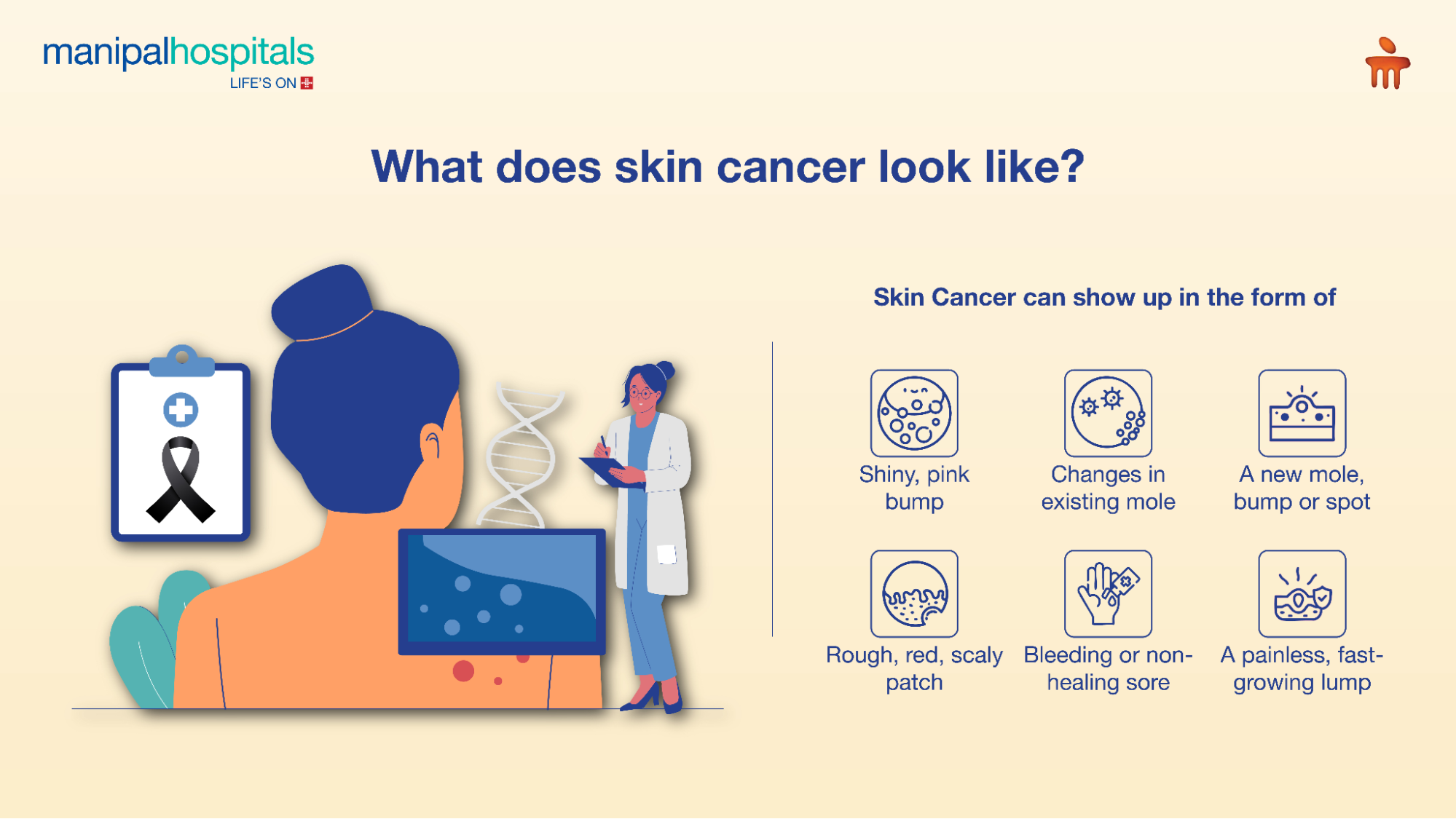
Skin cancers stand as one of the most common groups of cancers worldwide, with over 1.5 million new cases detected in 2022. Despite being the 17th most common cancer, melanomas account for a larger number of deaths compared to non-melanoma cancers that rank 5th. Both melanoma and non-melanoma skin cancers have several contributing factors, with exposure to the sun being the primary one. The sun's harmful rays can cause skin cancer. Avoiding direct contact with the harmful rays is the key to preventing skin cancer.
This blog answers the pivotal question- ‘how to prevent skin cancer?’ with some practical, everyday tips. But it is imperative to understand skin cancer, its types and causes before that.
Synopsis
What is skin cancer?
Skin cancer is an uncontrolled, abnormal growth of cells in the outer layer of the skin. This happens when the skin cell DNA is damaged, mainly due to radiation from the sun. Broadly classified as ‘melanoma’ and ‘non-melanoma’ cancers, these cells can invade and destroy healthy body tissues.
Melanoma
This cancer starts in the ‘melanocyte’, the cell found in the deepest layers of the skin and in the eyes, that produces and contains the pigment called melanin. Though less common as compared to other forms of skin cancer, melanoma is more aggressive and the deadliest of all skin cancers. It is much more likely to spread to other parts of the body.
Non-melanoma
These cancers begin in other skin cells. Despite being the most common type of skin cancer, these have a high survival rate. These slow-growing cancers can be further categorised as:
-
Basal Cell Carcinoma (BCC)- The most common type of skin cancer that occurs in the basal cells at the bottom of the epidermis (outer layer of the skin). These shiny, pinky bumps are slow-growing and are less likely to spread.
-
Squamous Cell Carcinoma (SCC)- Appears in the squamous cells or the top layer of the epidermis. The red flaky patches are the second most common type of skin cancer and are more aggressive than BCC. Left untreated, this can spread to other parts of the body.
-
Markel Cell Carcinoma (MCC)- This is a rare yet aggressive form of skin cancer that appears on the head and neck as painless bumps that grow fast on sun-exposed skin.
What causes skin cancer?
The first step to skin cancer prevention is identifying the causes or risk factors related to different types of skin cancers:
-
UV radiation and DNA changes- The leading cause of skin cancers is exposure to the harmful UV (ultraviolet) radiation, mainly from the sun, besides artificial sources like tanning beds or sun lamps. This radiation induces DNA mutations in skin cells cause them to grow uncontrollably and form tumours.
-
Other causes- Apart from radiation damage, certain other such as a weakened immune system and previous skin damage can contribute to skin cancer development.
What are the signs of skin cancer?
Preventing skin cancer or its complications becomes easy with awareness towards the symptoms of this disease. The common ones include:

-
A new mole or spot on the skin
-
Change in the shape, size, and colour of an existing mole
-
A shiny red or skin coloured bump
-
A red patch that feels dry, rough or scaly
-
An itching or hurting spot
-
Any sore that does not heal after four weeks or more
How can you avoid skin cancer?
The good news is that there are many methods on how to prevent skin cancer. Avoiding skin cancer is possible only if the risk factors are kept at bay. This can be achieved by:
Sun protection
The sun’s UVB rays cause sunburn and directly damage DNA, causing skin cancers. Whereas the UVA rays go deeper, resulting in skin ageing and inflammation, which indirectly damages DNA and increases cancer risk over time. Thus, sun protection remains the bottom-line in preventing skin cancer. One must-
-
Apply a broad-spectrum sunscreen with SPF (Sun Protecting Factor) of 50+ or above. This should be applied every day on the face and all uncovered areas of the body, irrespective of being indoors or outside. Re-application is advised every 2 hours and after swimming/sweating.
-
Wear protective clothing like full sleeves garments and hats, or use sunglasses and umbrellas.
-
Avoid being outdoors or seek a shady place when outside between 10am and 4pm.
-
Keep away from tanning beds.
Check-up
Keeping an eye on anything that is out of place helps in the early detection of skin cancers. Timely detection and prompt treatment ensure a better prognosis and increased survival rates. One should-
-
Do a skin check-up regularly at home for unusual spots or moles.
-
Follow the ABCDE rule for detecting mole changes -
Asymmetry in both halves
Border is irregular, blurred, ragged, or notched
Colour is uneven and is a shade of brown, black or tan with patches of white, blue, pink, or red
Diameter is larger than 6 millimetres
Evolving changes that include size, shape, colour, bleeding, itching, or crusting
- Visit a dermatologist once a year, or if symptoms appear.
How is skin cancer treated?
Treating skin cancer depends on its type, stage and location. Early-stage cancers are treated surgically. Advanced cancers may call for a combination of treatment approaches, involving surgery and systemic therapies.
Medical Treatment
This comprises-
-
Tropical creams- Creams or ointments that are directly applied to the affected area of the skin.
-
Chemotherapy- Drugs that kill the cancer cells are either applied locally for early-stage cancers and taken systemically for advanced-stage cancers.
-
Targeted therapy- Drugs are used to target cancer cells and block their growth.
-
Radiation therapy- High-energy beams are used to kill the cancer cells.
-
Immunotherapy- Empowers the patient’s immune system to fight the diseased cells.
Surgical Treatment
The various procedures used involve-
-
Simple excision- The tumour is cut off along with some surrounding cells.
-
Mohs Micrographic Surgery- For cancers that are ill-defined or in sensitive areas, the tumour is removed layer by layer and examined under the microscope to check for any remaining cancer cells.
-
Shave excision- A tumour that is small and non-aggressive is shaved off the surface of the skin.
-
Curettage and electrodesiccation- The tumour is scraped away, and the base is burnt off.
-
Cryosurgery- The cancer cells are frozen and destroyed using liquid nitrogen.
-
Laser surgery- Surface lesions are removed with a laser beam, making bloodless cuts.
Lifestyle Modifications
Lifestyle modifications may not be a replacement for medical care, but they can complement the process of cancer prevention or healing. These includes-
-
A diet rich in antioxidants to support skin repair, such as fruits, vegetables, whole grains, healthy fats, and omega-3 fatty acids.
-
Natural oils like aloe vera or green tea extracts may help soothe UV-damaged skin.
-
Green tea containing polyphenols has anti-cancer effects.
-
Curcumin, present in turmeric, carries anti-inflammatory and anti-carcinogenic properties.
-
Vitamin B3 is believed to prevent non-melanoma lesions.
-
Vitamin C & E help to protect from UV ray damage.
-
Carotenoids found in red and orange produce, like carrots and tomatoes, can prevent photodamage.
Conclusion
Skin cancer protection is largely possible with consistent care and awareness. Protecting your skin from the sun, checking regularly for unusual changes, and seeking timely medical advice are key steps to staying safe. Simple habits like using sunscreen, covering up, and avoiding peak sun hours are examples of how to prevent skin cancer that can go a long way.
The Dermatology Department at Manipal Hospitals Siliguri is adept in diagnosing and treating a huge array of skin disorders and cancers. Advanced infrastructure and years of expertise guarantee the possible treatment for its patients. Reach out to our skin specialists at the earliest for any skin condition.
FAQ's
Factors leading to increased risk for skin cancer include fair skin, history of sunburns, frequent sun exposure, family history of skin cancer, or weakened immunity.
Yes, skin cancer can return after treatment, especially if preventive care isn’t followed. Regular follow-ups and consistent sun protection are essential to reduce the risk of recurrence.
Not always. Early cancers or lesions are often painless, which is why self-checks are important. Pain, itching, or bleeding can be seen in more advanced cases.
To naturally prevent skin cancer, focus on UV protection through clothing, shade, and sunscreen, and maintain a healthy diet rich in fruits, vegetables, and specific nutrients like selenium and omega-3s. Avoiding tanning beds, seeking shade during peak sun hours, and eating a diet with a low-fat, high-vegetable content can also significantly lower your risk.
No. Skin cancer can never spread from one person to another. It develops due to mutations within one’s own skin cells and is not caused by germs or pathogens that can be transmitted.
Rarely, yes. Long-standing scars, burns, or chronic wounds can sometimes turn into squamous cell carcinoma. Therefore, such areas should be monitored closely for any abnormality or changes.
While there are no natural skin cancer treatment methods, following lifestyle modifications such as having a diet rich in antioxidants can help can complement the healing process.






















 6 Min Read
6 Min Read










